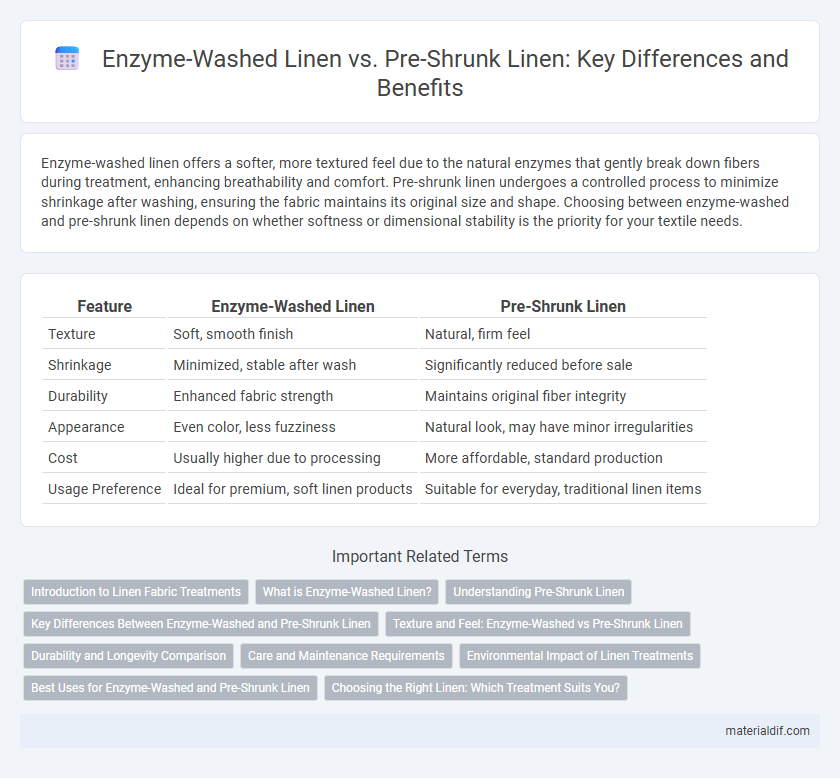Enzyme-washed linen offers a softer, more textured feel due to the natural enzymes that gently break down fibers during treatment, enhancing breathability and comfort. Pre-shrunk linen undergoes a controlled process to minimize shrinkage after washing, ensuring the fabric maintains its original size and shape. Choosing between enzyme-washed and pre-shrunk linen depends on whether softness or dimensional stability is the priority for your textile needs.
Table of Comparison
| Feature | Enzyme-Washed Linen | Pre-Shrunk Linen |
|---|---|---|
| Texture | Soft, smooth finish | Natural, firm feel |
| Shrinkage | Minimized, stable after wash | Significantly reduced before sale |
| Durability | Enhanced fabric strength | Maintains original fiber integrity |
| Appearance | Even color, less fuzziness | Natural look, may have minor irregularities |
| Cost | Usually higher due to processing | More affordable, standard production |
| Usage Preference | Ideal for premium, soft linen products | Suitable for everyday, traditional linen items |
Introduction to Linen Fabric Treatments
Enzyme-washed linen undergoes a biological process using enzymes to soften fibers and enhance texture, resulting in a smoother and more flexible fabric ideal for apparel and home textiles. Pre-shrunk linen is treated through controlled washing and drying techniques to reduce future shrinkage, ensuring garment longevity and consistent fit after multiple washes. Both treatments improve linen's durability and comfort while catering to different consumer needs regarding fabric feel and maintenance.
What is Enzyme-Washed Linen?
Enzyme-washed linen undergoes a treatment process using natural enzymes that break down the fibers' surface, resulting in a softer, smoother texture and enhanced breathability. This method reduces fabric stiffness and enhances color retention while maintaining the linen's durability and natural appearance. Enzyme-washing also minimizes pilling, offering a lightweight and comfortable fabric ideal for warm-weather clothing and home textiles.
Understanding Pre-Shrunk Linen
Pre-shrunk linen undergoes a controlled washing process before cutting and stitching to minimize future shrinkage, ensuring garments retain their original size and shape after washing. This treatment stabilizes the linen fibers, providing durability and consistent fit, which is essential for maintaining linen's natural texture and breathability. Unlike enzyme-washed linen, which softens the fabric and enhances texture, pre-shrunk linen prioritizes dimensional stability and long-term garment performance.
Key Differences Between Enzyme-Washed and Pre-Shrunk Linen
Enzyme-washed linen undergoes a biological treatment that softens the fabric and reduces surface fuzz, creating a smoother texture, whereas pre-shrunk linen is mechanically treated to minimize shrinkage during washing. Enzyme washing enhances linen's durability and color retention by breaking down pectins in the fibers, while pre-shrunk processes focus mainly on dimensional stability without altering fabric hand feel significantly. The distinction lies in enzyme-washed linen offering improved softness and fabric longevity, compared to pre-shrunk linen's primary benefit of maintaining size after laundering.
Texture and Feel: Enzyme-Washed vs Pre-Shrunk Linen
Enzyme-washed linen features a softer, smoother texture due to the enzymatic treatment that breaks down fibers, creating a more worn-in, relaxed feel. Pre-shrunk linen maintains a crisper, firmer texture as it undergoes heat or mechanical processes to reduce shrinkage without altering the fabric's natural stiffness. The enzyme-washing process enhances linen's breathability and drape, while pre-shrunk linen offers durability and shape retention with a more structured hand.
Durability and Longevity Comparison
Enzyme-washed linen undergoes a bio-chemical process that softens the fabric while maintaining its natural fibers, resulting in enhanced durability and a unique texture that improves with age. Pre-shrunk linen is treated to reduce post-purchase shrinkage but may sacrifice some fiber strength due to heat exposure during processing. Overall, enzyme-washed linen offers superior longevity and resilience compared to pre-shrunk linen, making it ideal for long-lasting textile products.
Care and Maintenance Requirements
Enzyme-washed linen offers a softer texture and reduced shrinkage compared to untreated fabric, requiring gentle machine washing with mild detergents to maintain its quality. Pre-shrunk linen undergoes a controlled shrinking process, allowing it to retain size and shape with standard washing and minimal special care. Both treatments enhance fabric durability, but enzyme-washed linen benefits from lower-temperature washes and air drying to prevent damage, while pre-shrunk linen is more forgiving during routine maintenance.
Environmental Impact of Linen Treatments
Enzyme-washed linen uses natural enzymes to break down fibers, reducing chemical use and water consumption, making it a more eco-friendly option compared to traditional pre-shrunk linen treatments that often rely on synthetic chemicals and extensive washing processes. Pre-shrunk linen involves repeated washing at high temperatures to stabilize the fabric, resulting in higher energy use and increased water pollution. Choosing enzyme-washed linen supports sustainable textile production by minimizing environmental degradation and promoting biodegradable treatment methods.
Best Uses for Enzyme-Washed and Pre-Shrunk Linen
Enzyme-washed linen offers a softer texture and reduced stiffness, making it ideal for casual clothing, bedding, and home textiles where comfort and breathability are prioritized. Pre-shrunk linen maintains its original structure and provides consistent sizing, which is best suited for tailored garments, upholstery, and precision-fit apparel. Choosing enzyme-washed linen enhances wearability and longevity in relaxed settings, while pre-shrunk linen ensures reliable durability and shape retention in structured applications.
Choosing the Right Linen: Which Treatment Suits You?
Enzyme-washed linen offers a softer texture and improved breathability due to the breakdown of cellulose fibers during treatment, ideal for those seeking lightweight, comfortable fabrics. Pre-shrunk linen, treated through heat-setting processes, maintains its original size after washing, perfect for individuals who prioritize durability and consistent fit. Selecting between enzyme-washed and pre-shrunk linen depends on whether softness or size stability is the primary concern for your clothing or home textile needs.
Enzyme-washed Linen vs Pre-shrunk Linen Infographic

 materialdif.com
materialdif.com